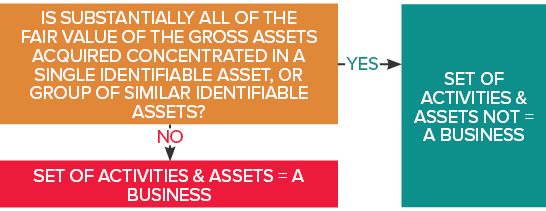How the optional concentration test could save you time assessing whether you have acquired a business
When purchasing an entity or ‘business’, acquirers need to assess whether they have acquired assets, or whether they have acquired a ‘business’ in accordance with IFRS 3 Business Combinations. This can be a time consuming and sometimes complex process.
In November 2018 Accounting News we discussed changes made to the definition of a ‘business’ in IFRS 3, which will change this assessment for acquisitions occurring on or after 1 January 2020 (i.e. the changes apply to 30 June 2020 half-years and 31 December 2020 year-ends for the first time). The amendments were effected in Australian via AASB 2018-6 Amendments to Australian Accounting Standards – Definition of a Business.
Optional ‘concentration test’
In addition to amending the definition of a ‘business’, the changes also introduce an optional ‘concentration test’ which, if used, could save acquirers a significant amount of time because they will not be required to perform a formal assessment to determine whether an acquired set of activities and assets constitutes a ‘business’.
How does the optional ‘concentration test’ work?
The ‘concentration test’ is optional. Entities may choose to apply, or not to apply this simplified assessment process for each acquisition.
If the ‘concentration test’ is met, the acquired set of activities and assets is determined not to be a business. If the test is not met, or if the acquirer elects not to apply the test, then a full assessment needs to be determined to assess whether a business has been acquired or not.
‘Concentration test’ criteria
IFRS 3, paragraph B7B sets out the criteria for the ‘concentration test’ to apply. The key driver is that substantially all of the fair value of the gross assets acquired must be concentrated in a single identifiable asset or group of similar identifiable assets. This is illustrated in the diagram below.

Judgement is required to determine whether ‘substantially all’ the fair value is concentrated in a single asset or group of assets.
Acquirers will need to apply some additional rules when performing the ‘concentration test’. These are set out in IFRS 3, paragraph B7B and summarised below:
- Gross assets acquired do not include cash and cash equivalents, deferred tax assets and goodwill arising from the effects of deferred tax liabilities.
- The fair value of the gross assets acquired includes any consideration transferred (plus the fair value of any non-controlling interest and the fair value of any previously held interest) in excess of the fair value of net identifiable assets acquired.
- A single identifiable asset must include any asset or group of assets that would be recognised and measured as a single identifiable asset in a business combination.
- If a tangible asset is attached to, and cannot be physically removed and used separately from, another tangible asset, or from an underlying asset subject to a lease without incurring significant cost, or significant diminution in utility or fair value to either asset (for example, land and buildings), those assets are considered a single identifiable asset.
- When assessing whether assets are similar, an entity shall consider the nature of each single identifiable asset and the risks associated with managing and creating outputs from the assets (that is, the risk characteristics).
- The following are not be considered to be similar assets:
- A tangible asset and an intangible asset
- Tangible assets in different classes (.e.g. inventory, manufacturing equipment and automobiles) unless they are considered a single identifiable asset in accordance with (d) above
- Identifiable intangible assets in different classes (e.g. brand names, licences and intangible assets under development)
- A financial asset and a non-financial asset
- Financial assets in different classes (e.g. accounts receivable and investments in equity instruments), and
- Identifiable assets that are within the same class of asset but have significantly different risk characteristics.
Examples where the ‘concentration test’ may be used
The Illustrative Examples to IFRS 3 demonstrate some examples where the concentration test could be met, and the acquisitions accounted for as asset acquisitions rather than business combinations.
Need assistance?
Please contact BDO’s IFRS Advisory team if you require assistance with business combination accounting and applying the ‘concentration test’.